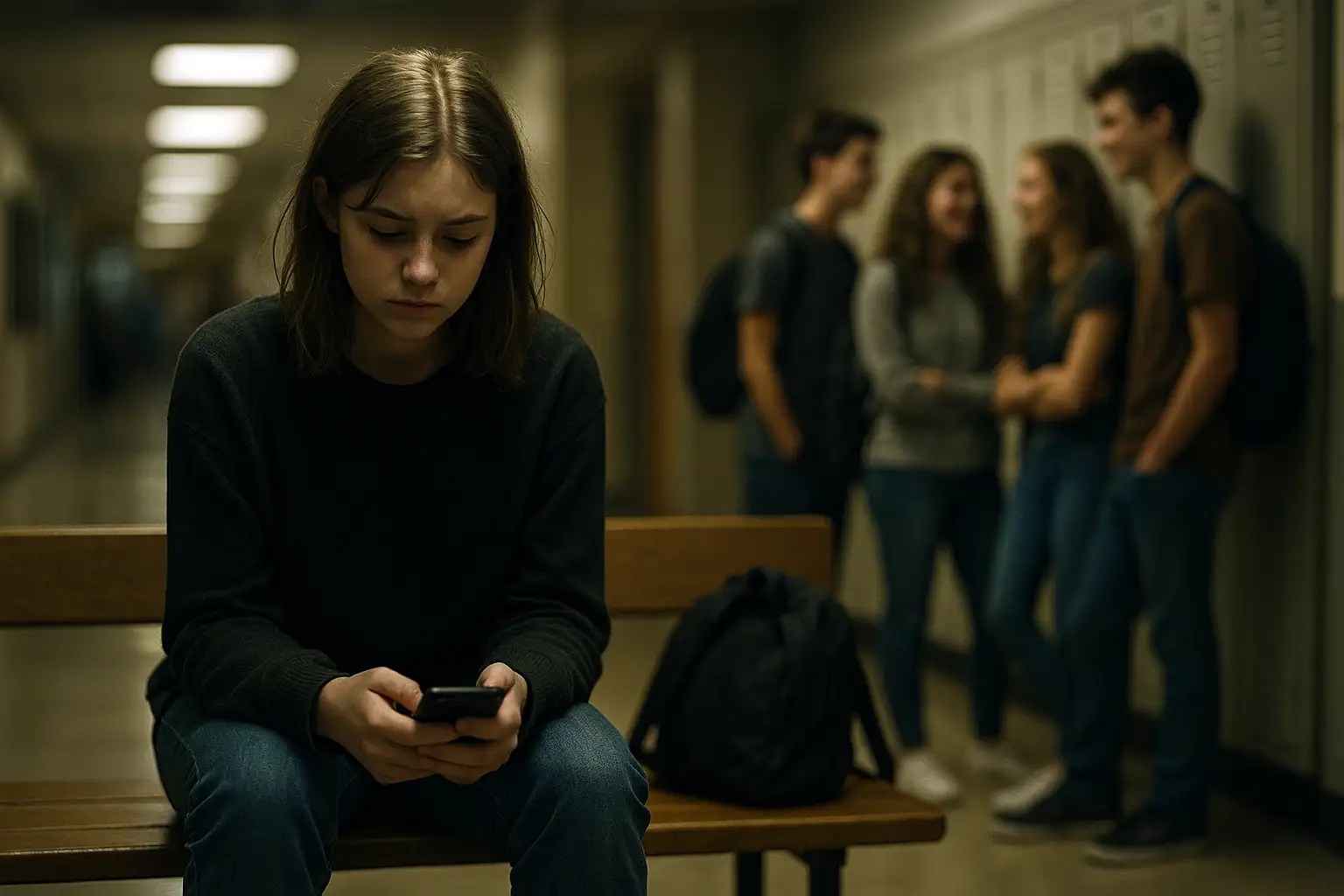Navigating the social world of adolescence is challenging for any parent. You watch closely, hoping your child finds a supportive friend group, but often worry about the powerful and negative ways cliques influence teen development. What may seem like typical teenage drama can often mask a more harmful dynamic. Unlike healthy friendships, toxic cliques don’t just offer companionship; they actively and dangerously shape your child’s choices, self-esteem, and future.
Understanding this influence is not about stifling your teen’s social life—it’s about empowering them. By recognizing the specific mechanisms through which cliques operate, you can intervene effectively. This article breaks down the five most dangerous ways these groups impact behavior and provides a clear, actionable plan to help you stop the cycle and guide your teen toward healthier relationships.
1. They Encourage Risky and Impulsive Decision-Making
The phrase “safety in numbers” takes on a dangerous twist within a teen clique. It’s not safety from harm, but a perceived safety from consequence and accountability. This phenomenon, often called the “mob mentality” or deindividuation, strips away a teen’s individual sense of responsibility. Their identity temporarily merges with the group’s, and the desire to impress the leader or maintain status can completely override their own better judgment and the internal moral compass you’ve worked to build.
The Psychology Behind the Pressure:
It’s more than just “peer pressure.” It’s a potent cocktail of factors:
- Anonymity: In a group, individual actions feel blurred. A teen might think, “No one will notice if I’m the one who throws the first egg,” or “We’re all doing it, so I won’t get singled out.”
- Bravado: Cliques are often performative. Risky acts become a currency to buy social capital. A daring stunt or a willingness to break rules is seen as proof of loyalty and coolness.
- Fear of Ostracization: This is the ultimate motivator. The thought, “If I don’t do this, they’ll kick me out or mock me forever,” can feel more immediately terrifying than the long-term risk of the action itself.
The Danger in Action: A Real-World Scenario
Consider a common situation: a group of teens at a party where alcohol is present. Alone, your child might easily refuse a drink. But within the clique, the dynamic changes. The leader might hand them a drink with a challenging, “Don’t be a baby. We’re all doing it.” Saying “no” now isn’t just about personal choice; it’s a public rejection of the group’s norms. The fear of being labeled “uncool” or “judgmental” in that moment can overpower their knowledge that drinking is a bad idea. This can quickly escalate from a single drink to more dangerous dares, like reckless driving or vandalism, as the group’s impulsivity spirals.

The consequences extend beyond the immediate risk of accident or punishment. This pattern teaches teens to outsource their decision-making to the group, hindering the development of their own critical thinking and impulse control—a crucial skill for adulthood.
How to Stop It: Building a Foundation of Critical Thinking and Safety
Moving beyond simple warnings requires a proactive, two-pronged approach that builds your teen’s internal strength and provides a practical safety net.
1. Foster Critical Thinking Through “What-If” Scenarios (Before a Crisis Hits):
Instead of lecturing after an incident, use calm moments to build their analytical skills. Frame it as a hypothetical game or discussion. The goal is to get them to think through consequences on their own.
- Go Deeper Than “Just Say No”: Ask open-ended questions that force them to consider social and emotional outcomes:
- “If everyone in a group decided to do something dangerous, what could a person say to bow out without losing total face?”
- “Why do you think people feel pressured to do things in a group that they’d never do alone? What’s going on in their head?”
- “If a friend was being pressured to steal something, what’s a good way they could deflect or change the subject?”
- Role-Play Scenarios: Practice quick, assertive phrases they can use. “Nah, that’s not my thing,” or “I’ve got a crazy early morning tomorrow, I’m out,” can be easier to deploy than a flat-out refusal. This gives them a ready-made script, reducing panic in the moment.
2. Formalize the “Exit Strategy”: A No-Shame Safety Plan:
The code word is an excellent start, but making it a formal family plan removes any lingering doubt or embarrassment.
- The Code Word/Text: Agree on an unambiguous signal. It could be a word like “pickle” or a simple emoji like 🩵. The key is that it means: “Come get me immediately, no questions asked. I feel unsafe.”
- The Guarantee: Publicly and repeatedly assure your teen of the following promise:
- You will not be angry about the situation when you pick them up.
- You will not grill them that night. The car ride home will be quiet if they want it to be.
- You will discuss it the next day calmly, not as an interrogation, but as a “debrief” to understand what happened and how to handle similar situations in the future.
- The Goal: This plan decouples their safety from their fear of getting in trouble. It empowers them to prioritize their well-being over social standing, knowing they have a guaranteed, shame-free escape route.
By combining these strategies, you’re not just forbidding bad behavior; you’re actively equipping your teen with the tools to navigate complex social pressures, trust their own judgment, and know that your support is unconditional.
2. They Stifle Individual Identity and Self-Discovery
Adolescence is the primary crucible for forging a personal identity. It’s a time when teens naturally ask, “Who am I?” outside of their family unit. Healthy friend groups provide a safe space to explore this question. Toxic cliques, however, provide a rigid, pre-fabricated answer. The unspoken rule of a clique is conformity: members are expected to adopt a group-approved uniform (in dress, speech, and interests), share the same opinions, and ridicule the same outsiders. Within this structure, individuality isn’t just discouraged; it’s often treated as betrayal, a direct threat to the group’s fragile cohesion and perceived superiority.
The Erosion of the Self: The Conformity Mechanism
This goes beyond simply liking the same music. The pressure is systemic and subtle:
- Opinion Adoption: A teen might suppress their genuine enjoyment of a book or a movie because the clique leader has deemed it “lame.” They learn to echo the group’s judgments to avoid being judged themselves.
- Passion Abandonment: A budding artist might hide their sketchbook; a passionate gamer might downplay their hobby if it doesn’t align with the clique’s “cool” image. They sacrifice authentic passions for group-approved activities.
- Moral Compromise: The teen’s own values of kindness or honesty can be eroded if the clique’s culture rewards gossip, exclusion, or cruelty. They silence their inner voice to maintain their social standing.
The Danger in Action: A Real-World Scenario
Imagine your daughter, who has always loved science fiction and coding, finds herself in a clique that prioritizes social media aesthetics and popularity. She stops talking about the new novel she’s reading, hides her coding projects, and instead spends hours curating a perfect online persona that mirrors her friends’. She might even join in on mocking other “nerdy” kids.
The immediate reward is social acceptance, but the long-term cost is the disconnection from her authentic self. This creates a phenomenon psychologists call “self-alienation”—she no longer recognizes herself. The constant performance leads to chronic anxiety, low self-esteem, and a weak, fragmented sense of identity that is entirely dependent on external validation.
How to Stop It: Cultivating an Authentic Self
Combating this requires a deliberate and consistent effort to create a counterweight to the clique’s pressure. The goal is to make your home a sanctuary where your teen’s true self is not just allowed, but celebrated.
1. Actively Sponsor Diverse Interests and “Identity Portfolios”:
This strategy is about helping your teen build a sense of self that exists outside the clique’s jurisdiction. It provides tangible evidence that their unique interests have value.
- Fund and Facilitate Exploration: If your teen shows even a fleeting interest in something—be it rock climbing, journalism, volunteering at an animal shelter, or a new instrument—actively support it. Drive them to the first session, buy the beginner’s kit, and show genuine curiosity. This signals that their exploration is worthwhile.
- Reframe the Goal: Position these activities not as an escape from friends, but as an investment in themselves. Use language like, “This is your thing,” or “It’s so cool that you’re building this skill.” This helps them develop what researchers call an “identity portfolio”—multiple sources of self-worth that make them less vulnerable to the approval of a single group.
2. Practice “Character-First” Praise and Deconstruct Groupthink:
Shift the focus of your compliments from external achievements (which can be tied to conformity) to internal character traits. This reinforces that their inherent value is separate from their social performance.
- Praise the Process, Not the Popularity: Instead of “You and your friends look so cool in that picture,” try:
- “I really admired how kind you were to your younger cousin today.”
- “That took a lot of courage to speak up about what you thought was right.”
- “Your creativity in solving that problem was impressive.”
- Engage in Gentle Reality Testing: When you notice them parroting a clique opinion, engage their critical mind in a non-confrontational way. Ask, “That’s an interesting point. What makes you say that?” or “I remember you used to really enjoy [X]. Has your opinion on that changed?” This encourages self-reflection without making them defensive.

3. Create “Identity-Safe” Zones at Home:
Ensure your home is a place where your teen can let their guard down. This means minimizing criticism about their clothing, music, or room decor (within reason) and allowing them to express a full range of emotions—boredom, excitement, sadness—without judgment. When home is a place where they don’t have to perform, they have the mental space to remember who they truly are, strengthening their core identity against the pressures of the outside world.
3. They Normalize Bullying and Meanness
Within the ecosystem of a clique, aggression is often repackaged as social currency. To solidify their internal bonds and maintain a hierarchy, these groups frequently create a “common enemy.” This target can be anyone perceived as different, vulnerable, or a threat to the clique’s status. The resulting behaviors—systematic exclusion, vicious gossiping, and public humiliation—are not seen as bullying by the members, but as necessary tactics for social survival and entertainment. Being mean is mistakenly equated with being powerful, and cruelty becomes a normalized, even rewarded, part of daily interaction.
The Social Mechanics of Group Cruelty:
This normalization occurs through several powerful mechanisms:
- Diffusion of Responsibility: In a group, no single individual feels fully responsible for the outcome. A teen might think, “I just shared the rumor, I didn’t start it,” or “Everyone was laughing, so it wasn’t just me.” This dilutes their sense of personal accountability.
- The Bystander Effect: Even members who feel uncomfortable are often silent, assuming someone else will speak up. Their inaction is misinterpreted as approval, encouraging the aggressors and isolating the target further.
- Social Contagion: Mocking and gossip spread quickly through the group like a virus, creating a shared sense of superiority. Participating becomes a way to prove loyalty and avoid becoming the next target.
The Danger in Action: A Real-World Scenario
Consider a scenario involving a cyberbullying campaign. A member of the clique takes an unflattering picture of a classmate outside the group. They share it in a private group chat with a cruel caption. The act is initially led by one person, but it quickly escalates as others pile on with laughing emojis, additional insults, and shares. Your teen, wanting to stay in the group’s good graces, might contribute a minor comment or simply remain silent, “liking” a message to go along with the crowd.
The immediate effect is harm to the target, but the long-term danger is the desensitization of your teen’s moral compass. They are learning that causing emotional pain is an acceptable way to bond, damaging their capacity for empathy and increasing the likelihood they will become either a perpetual perpetrator or a target themselves if the clique’s allegiance shifts.
How to Stop It: Reinforcing Empathy and Ethical Courage
Combating this requires moving beyond simple definitions to actively building your teen’s moral resilience and giving them the tools to make ethical choices under social pressure.
1. Explicitly Define and Deconstruct “Social Bullying”:
Many teens believe that if they haven’t hit someone, they aren’t bullying. It’s crucial to make the invisible, visible.
- Provide a Concrete List: Clearly outline the behaviors that constitute emotional and social bullying:
- Exclusion: Deliberately leaving someone out of conversations, activities, or online groups.
- Gossip and Rumors: Spreading private or false information to damage someone’s reputation.
- Relational Aggression: Using friendships as weapons (e.g., “I won’t be your friend if you talk to her.”).
- Cyberbullying: Any of the above behaviors carried out through digital devices.
- Discuss the “Why”: Explain why these actions are so damaging. Talk about the lasting psychological effects of social rejection, linking it to anxiety, depression, and academic struggles. This moves the concept from a simple rule (“don’t be mean”) to a matter of human impact.
2. Model and Practice “Moment of Choice” Empathy:
Empathy is a muscle that must be exercised. Use real-life events, news stories, or scenes from movies to create a habit of perspective-taking.
- Ask “Impact” Questions: When a situation arises, either in your teen’s life or in the media, guide the conversation beyond the surface.
- Instead of just “That was mean,” ask, “How do you think Sarah felt when she saw the party photos online and realized she was the only one not invited?”
- Follow up with, “What do you think she thought about herself the next day at school?” and “Who could she turn to for support?”
- For online behavior, ask, “How is typing a cruel comment different from saying it to someone’s face? Is it easier? Is the hurt less?”
- Role-Play Intervention: Practice what to do when they witness bullying. Brainstorm phrases that are low-risk but impactful:
- Changing the subject: “Hey, can we talk about something else?”
- Showing support to the target later: “I’m sorry that happened. That wasn’t cool.”
- Directly (if they feel safe): “Okay, that’s enough.”
3. Empower the “Active Bystander”:
Reframe the role from a passive “bystander” to an “active bystander” who has power. Explain that silence is often interpreted as agreement. Empower them with small, manageable actions they can take that don’t necessarily involve direct confrontation, such as:
- Privately messaging the target to offer support.
- Not liking or sharing the harmful post.
- Talking to a trusted adult (like a parent, teacher, or counselor) about what they saw, framing it as a concern for everyone’s well-being.
By focusing on these strategies, you help your teen develop the ethical courage to resist the toxic norms of the clique, protecting both others and their own character.
4. They Create Unhealthy Dependency and Anxiety
Unlike healthy friendships built on mutual trust and support, clique dynamics are a breeding ground for insecurity. These relationships are transactional and conditional, often governed by an unspoken social ledger where every interaction is scored. For a teen inside this bubble, their social survival feels perpetually at stake. They exist in a state of hyper-vigilance, constantly monitoring group chats, analyzing tones of voice, and decoding social media posts for signs of approval or impending exile. This isn’t friendship; it’s a high-stakes game where the price of losing is social oblivion.
The Psychology of the Anxiety Cycle:
The clique creates a classic negative feedback loop that fuels dependency:
- The Threat: The teen fears ostracization above all else.
- The Behavior: To avoid this threat, they engage in people-pleasing, conformity, and intense monitoring of group dynamics.
- The “Reward”: Their compliance is met with temporary inclusion, which reinforces the idea that their anxiety-driven behavior is necessary for survival.
- The Escalation: This cycle repeats, tightening the clique’s grip. The teen becomes less capable of independent thought or action because their emotional stability is now chemically and psychologically tied to the group’s favor. They become addicted to the intermittent reinforcement of acceptance.
The Danger in Action: A Real-World Scenario
Imagine your son has a major test tomorrow. Instead of studying, he’s frantically scrolling through a group chat where plans for a spontaneous hangout are being made. He wasn’t initially included. His heart races as he watches the messages fly. If he asks to join, he might be seen as “needy.” If he doesn’t, he risks being left out permanently. He finally messages, “Sounds fun! Can I come?” and then stares at the phone for 20 minutes in agony, waiting for a reply.
The relief he feels when he gets a “k” is palpable, but it’s immediately replaced by stress about the test he hasn’t studied for. His academic performance suffers, his sleep is ruined, and his sense of self-worth is entirely dictated by a single, ambivalent text message.
How to Stop It: Building Internal Validation and a Secure Base
The goal is to break the cycle by weakening the clique’s power as the sole source of validation and strengthening your teen’s internal sense of security.
1. Be an Unconditional “Safe Harbor” – The Anti-Clique:
Your home must consciously function as the polar opposite of the clique’s conditional environment. This is a deliberate practice.
- Suspend Judgment: This is the hardest part. When your teen talks about clique drama, avoid immediate reactions like, “Those kids are terrible!” or “Just leave the group!” This can make them defensive and shut down communication. Instead, listen actively. Use phrases like, “That sounds incredibly stressful,” or “It makes sense that you feel hurt by that.”
- Decouple Performance from Worth: Make it explicit that their value in your family is not based on their social success, grades, or anything they do. It is based on who they are. Regularly express love and appreciation that is separate from achievements.

2. Master the Art of the Open-Ended, Low-Pressure Question:
The goal of these questions is to invite conversation without triggering the defensive walls they’ve built up.
- Move Beyond “How was your day?”: Instead of broad questions that invite one-word answers, ask specific yet open-ended ones that show genuine curiosity about their world:
- “What was the most interesting thing you learned today?”
- “Did anything make you laugh today?”
- “If you could change one thing about your day, what would it be?”
- Listen for the “Door Knob” Moment: Often, a teen will share a crucial piece of information just as you think the conversation is over, like when you’re leaving their room. Be prepared to pause and listen without pouncing. This is when they often feel safest to reveal something important.
3. Teach and Model Emotional Self-Regulation:
Help your teen identify and manage the anxiety the clique provokes, giving them tools that don’t rely on the group’s validation.
- Name the Feeling: Help them label what they’re experiencing. “It sounds like you’re feeling really anxious about what they’ll think. That’s a normal reaction to that kind of pressure.”
- Practice Grounding Techniques: Introduce simple techniques to short-circuit anxiety in the moment, like the “5-4-3-2-1” method (Name 5 things you can see, 4 you can touch, 3 you can hear, 2 you can smell, 1 you can taste). This can help them regain a sense of control when they feel a social panic attack coming on.
5. They Hinder the Development of Authentic Social Skills
A clique functions like a social cage: it offers the illusion of safety and belonging but at the cost of freedom and growth. Within its rigid boundaries, social interactions follow a strict, unwritten script designed to maintain the hierarchy. There is no need to learn the nuanced art of initiating a conversation with a stranger, because the group is closed. There is no practice in resolving a disagreement with empathy and compromise, because dissent is often met with exclusion. The natural, organic process of friendships forming, evolving, and sometimes fading—a crucial life skill—is replaced by the static, forced loyalty of the clique.

The Social Skills Deficit: What Fails to Develop
The closed system of a clique creates significant gaps in a teen’s social-emotional toolkit:
- Conversation Initiation: They don’t learn the subtle cues of approaching someone new, finding common ground, or asking open-ended questions to build rapport.
- Conflict Resolution: Disagreements within a clique are often handled through passive aggression, gossip, or social punishment, not through direct, honest communication. The teen learns to avoid conflict at all costs rather than navigate it healthily.
- Social Flexibility: They become accustomed to a single social context. When placed in a different setting—a new class, a summer job, a college dorm—they lack the ability to adapt their behavior and connect with a diverse range of people.
- Reading the Room: Because clique dynamics are often predictable and insular, teens may fail to develop the ability to accurately read social cues and emotional states in people outside their immediate circle.
The Danger in Action: A Real-World Scenario
Imagine your daughter’s clique dissolves upon graduating high school. At her summer job or in her college freshman orientation, she is surrounded by potential new friends. However, she feels paralyzed. She never learned how to casually introduce herself or join a conversation already in progress. She interprets normal social awkwardness as personal rejection, because she’s only experienced the false “ease” of forced clique inclusion.
Alternatively, she might try to impose the rigid, exclusive rules of her old clique onto new, healthier groups, which pushes people away. The long-term result is profound loneliness and isolation, not because she is unlikeable, but because she never developed the fundamental skills to build genuine connections from scratch.
How to Stop It: Building Social Muscle Memory
The solution is to provide low-stakes, guided opportunities to practice the very skills the clique prevents from developing. Think of it as social muscle memory.
1. Advanced Social Scenario Practice: Beyond “Just Say Hi”
Move beyond basic role-playing to equip your teen with practical scripts and frameworks for common, anxiety-inducing social situations.
- Brainstorm Conversation Starters: Work together to develop a “toolkit” of open-ended questions they can use in different settings:
- In a class: “What did you think of that homework assignment?”
- At an event: “How do you know [host’s name]?”
- General: “What are you excited about this week?”
- Role-Play “Graceful Exits”: Teach them how to end a conversation politely, which is just as important as starting one. Practice phrases like, “Well, it was great talking to you! I should go grab a drink,” or “I need to catch up with someone over there, but I’ll see you later!”
- Practice Receiving (Gentle) Feedback: At home, create an environment where you can give gentle, constructive feedback on social interactions. For example, “I noticed when you told that story, you made great eye contact—that was really engaging.” This builds self-awareness.
2. Strategic “Social Bridge” Events:
The goal of hosting gatherings is not to throw a huge party, but to create a controlled environment where your teen can practice being a connector.
- The “Plus-One” Strategy: Encourage your teen to invite one or two acquaintances from outside their main clique to a low-pressure activity alongside one or two trusted friends. This could be getting pizza, going to a movie, or playing video games. The small, mixed group reduces the pressure to “perform” and allows for more natural interaction.
- Focus on an Activity: Choose an event that has a built-in focus (mini-golf, bowling, a board game). This gives the social interaction a structure and a shared goal, making conversation flow more easily than at an unstructured hangout.
- Debrief Afterwards: Afterwards, in a casual way, you can ask, “What was it like having [new person] along? They seemed really nice.” This helps them process the experience positively and see the value in broadening their social circle.
3. Encourage “Friendship Cross-Training”:
Frame involvement in different activities as a way to build diverse social skills, just like an athlete cross-trains.
- Highlight the Skill-Building: When they join a club, sport, or volunteer organization, point out the social environment. You might say, “The great thing about drama club is you get to practice collaborating with a totally different group of people. That’s a super useful skill.”
- Normalize Social Awkwardness: Explicitly tell them that everyone feels a little awkward when trying something new socially. Reducing the shame around initial awkwardness makes them more likely to persevere.
By implementing these strategies, you are not just helping them escape a clique; you are equipping them with the foundational social skills needed to build fulfilling, authentic relationships throughout their life.
Your Action Plan: It Starts with Connection
Stopping the negative influence of a clique isn’t about forbidding your teen from seeing their friends. That approach often backfires. The goal is to build your child’s resilience from the inside out.
“Parents need to focus on strengthening their child’s internal compass,” says Dr. Elena Rodriguez, a licensed family therapist. “When a teen has a strong sense of self-worth and knows what healthy friendship feels like, they become less susceptible to the toxic pull of a clique. The most powerful tool you have is your open, non-judgmental communication.”
Stay observant, keep the lines of communication open, and don’t hesitate to seek support from a school counselor or child psychologist if you’re concerned. By understanding these dangers and taking proactive steps, you can guide your teen toward healthier, happier social relationships.
Ressources
- StopBullying.gov
- Link: https://www.stopbullying.gov
- Description: A federal government website managed by the U.S. Department of Health and Human Services. It provides extensive information from various government agencies on what bullying is, its effects, and how to prevent and respond to it. Essential for understanding cyberbullying and legal frameworks.
- The American Psychological Association (APA) – Parenting Resources
- Link: https://www.apa.org/topics/parenting
- Description: Offers a wealth of articles, tips, and resources based on psychological science. Topics include child development, resilience, stress management, and building healthy relationships.
- The Jed Foundation (JED)
- Link: https://jedfoundation.org
- Description: A nonprofit that protects emotional health and prevents suicide for teens and young adults. Their resource library provides excellent guides on navigating social challenges, building resilience, and supporting your teen’s mental health.
- Common Sense Media
- Link: https://www.commonsensemedia.org
- Description: An invaluable resource for understanding the digital world your teen inhabits. Offers reviews, advice, and family guides on social media, cyberbullying, and digital citizenship.
- National Alliance on Mental Illness (NAMI) – Teen and Young Adult Resources
- Link: https://www.nami.org/Your-Journey/Teens-Young-Adults
- Description: Provides support, education, and information about mental health conditions that can be exacerbated by social stress, such as anxiety and depression. Includes a helpline and connection to local support groups.

